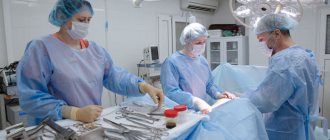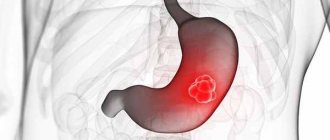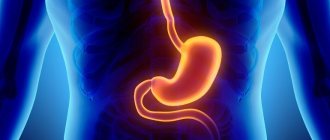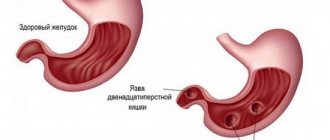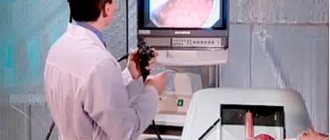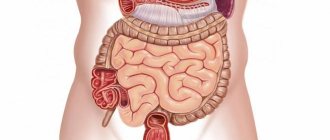Indications for surgery for stomach ulcers
Perforation of an ulcer (the occurrence of a through defect in the wall of the stomach or duodenum).- Bleeding from an ulcer that cannot be stopped with hemostatic agents and endoscopic hemostasis.
- Cicatricial narrowing of the outlet of the stomach, making it difficult for food to pass through.
- Long-term non-healing ulcers suspicious for malignancy.
- Often recurrent (more than 3-4 times a year) ulcers (relative indication).
- Combination of an ulcer with diffuse gastric polyposis (relative indication).
The main operations that are currently performed for peptic ulcer disease are gastric resection and suturing of the perforation.
Some other types of operations (vagotomy, pyloroplasty, local excision of an ulcer, gastroenteroanastomosis without gastrectomy) are performed very rarely today, since their effectiveness is much lower than gastrectomy. Vagotomy is performed mainly for duodenal ulcers.
Progress of the operation
The perforated hole is sutured using ether-oxygen anesthesia; local or combined anesthesia is very rarely used. A medium-sized incision is made on the anterior wall of the abdominal cavity, and the fluid that has leaked from the stomach is removed with an aspirator. Having discovered the site of the breakthrough, it is sutured with a transverse suture, corresponding to the axis of the organ. This technique is needed to ensure a reduction in the risk of developing stenosis in the postoperative period. An omentum is tied to the sutured ulcer. If there is a narrowing of the pyloric part of the stomach, then gastroenteroanastomosis is performed. Upon completion of suturing, the space around the ulcer is dried with gauze and the peritoneum is sutured in layers. In case of large ulcers, perforated hole plasty is performed. To do this, use a part of the omentum that is equal in thickness to the affected area of the mucosa.
The excision method is used to eliminate ulcerative openings if it is impossible to sutured them. The gastric ulcer is excised along with the perforated hole and the infiltration zone. The defect is sutured with an interrupted suture so as not to cause stenosis of the gastric lumen.
Gastric resection is performed using the Bellroth-1 and Bellroth-2 methods. In the first case, an anastomosis is created between the gastric stump and the duodenal stump. In the second case, the stump of the stomach is connected to the jejunum. This method is less effective, since the duodenum is completely excluded from the digestion process. Basically, 2/3 of the stomach is removed. This operation saves part of the organ and preserves the physiological abilities of the stomach.
Features of patient selection for surgical treatment of peptic ulcer
In emergency situations (perforation, bleeding), the question is about the life and death of the patient, and here there is usually no doubt about the choice of treatment.
When it comes to planned resection, the decision must be very balanced and thoughtful. If there is even the slightest opportunity to manage the patient conservatively, this opportunity should be used. The operation can get rid of the ulcer forever, but it adds other problems (quite often manifestations occur, designated as operated stomach syndrome).
The patient should be informed as much as possible about both the consequences of the operation and the consequences of not taking surgical measures.
Laser treatment: how is it performed?
Here is how laser treatment sessions for the stomach are currently performed for perforated ulcers:
- A rubber tube is inserted into the patient through the mouth, as is the case during conventional diagnostic fibrogastroscopy.
- Next, the doctor, through visual observation, cauterizes the ulcerative wound using a laser beam.
In order to obtain the desired effect from gastric ulcer surgery with a laser, the procedure must be repeated seven to ten times. This is very unpleasant for the patient. But such treatment is quite effective compared to conservative methods of therapy, although it is significantly inferior to surgical operations.
Diet for a perforated stomach ulcer is important. More on this below.
Operations for perforation of an ulcer
A perforated stomach ulcer is an emergency condition. If the operation is delayed, it can lead to the development of peritonitis and the death of the patient.
Usually, when an ulcer is perforated, it is sutured and the abdominal cavity is sanitized, and less often, an emergency gastrectomy is performed.
Preparation for emergency surgery is minimal. The intervention itself is performed under general anesthesia. Access – upper median laparotomy. A revision (examination) of the abdominal cavity is performed, a perforation hole is located (it is usually several millimeters), and it is sutured with absorbable thread. Sometimes, for better reliability, a large oil seal is sewn to the hole.
Next, the stomach contents and effusion that have entered there are sucked out from the abdominal cavity, and the cavity is washed with antiseptics. Drainage is being improved. A tube is inserted into the stomach to suction out the contents. The wound is sutured layer by layer.
The patient is on parenteral nutrition for several days. Broad-spectrum antibiotics are mandatory.
If the course is favorable, the drainage is removed on the 3-4th day, the sutures are usually removed on the 7th day. Working capacity is restored after 1-2 months.
When peritonitis develops, repeated surgery is sometimes required.
Suturing a perforated ulcer is not a radical operation, it is only an emergency measure to save life. The ulcer may recur. In the future, it is necessary to undergo regular examinations for early detection of exacerbations and the appointment of conservative therapy.
Surgery using vagotomy
In some cases, surgery for a perforated ulcer is performed using vagotomy. Vagotomy is a surgical operation to dissect the trunk or individual branches of the vagus nerve.
The essence of the use of vagotomy is the direct influence of the vagus nerve on gastric secretion. Its dissection leads to a significant reduction in it. This promotes the healing of operated perforated ulcers of the stomach and duodenum.
However, vagotomy does not always pay off and is dangerous due to serious complications. This is due to the fact that the vagus nerve affects not only the acidity of the stomach, but also its other functions and the functions of other internal organs. Thus, after vagotomy, post-vagotomy syndrome may appear - a violation of the evacuation of stomach contents, which can be fatal.
To reduce possible complications, various options for this procedure have been developed. The following main types of vagotomy are distinguished:
- stem;
- selective;
- selective proximal.
In the first case, the trunk of the vagus nerve is cut off; this method is more dangerous due to complications. With selective vagotomy, individual branches of the trunk are cut off. A safer option is selective proximal vagotomy, when only those branches that go to the body and fundus of the stomach, where secretion occurs, are cut off. This does not interfere with other functions of the stomach or the functioning of other organs.
Vagotomy is performed mechanically and chemically, both with open surgery and laparoscopy.
Gastric resection
The most common operation for peptic ulcer disease is gastric resection. It can be carried out both as an emergency (for bleeding or perforation) and as a planned procedure (chronic long-term non-healing, often recurrent ulcers).
From 1/3 (for ulcers located close to the outlet) to 3/4 of the stomach is removed. If malignancy is suspected, subtotal and total resection (gastrectomy) may be prescribed.
gastrectomy
Resection of part of the stomach is preferable, rather than simply excision of the area with the ulcer, because:
- Removing only the ulcer will not solve the problem as a whole, the peptic ulcer will recur, and you will have to do a second operation.
- Local excision of the ulcer followed by suturing of the stomach wall can subsequently cause severe cicatricial deformation with impaired passage of food, which will also necessitate a repeat operation.
- The gastric resection operation is universal, it has been well studied and developed.
Preparing for surgery
To clarify the diagnosis, the patient must undergo:
- Gastroendoscopy with biopsy from the ulcer.
- X-ray contrast examination of the stomach to clarify the function of evacuation.
- Ultrasound or CT scan of the abdominal cavity to clarify the condition of neighboring organs.
In the presence of concomitant chronic diseases, consultation with relevant specialists is necessary, compensation for vital systems (cardiovascular, respiratory, blood sugar levels, etc.). In the presence of foci of chronic infection, their sanitation is necessary (teeth, tonsils, paranasal sinuses).
At least 10-14 days before surgery, the following are prescribed:
- Blood and urine tests.
- Coagulogram.
- Determination of blood group.
- ECG.
- Biochemical analysis.
- Blood testing for the presence of antibodies to chronic infectious diseases (HIV, hepatitis, syphilis).
- Examination by a therapist.
- Gynecologist examination for women.
Progress of the operation
The operation is performed under general endotracheal anesthesia.
An incision is made along the midline from the sternum to the navel. The surgeon mobilizes the stomach and ligates the vessels leading to the part to be removed. At the border of removal, the stomach is stitched either with an atraumatic suture or with a stapler. The duodenum is stitched in the same way.
Part of the stomach is cut off and removed. Next, an anastomosis is performed (most often “side to side”) between the remaining part of the stomach and the duodenum, less often – the small intestine. A drain (tube) is left in the abdominal cavity, and a tube is left in the stomach. The wound is sutured.
You cannot eat or drink for several days after the operation (intravenous infusion of solutions and liquids is being established). The drainage is usually removed on the 3rd day. The stitches are removed on 7-8 days.
Painkillers and antibacterial drugs are prescribed. You can get up in a day.
Laparoscopic treatment of perforated ulcer
The laparoscopic (endoscopic) method of treating perforated ulcers is clearly presented in the video below.
Indications for laparoscopic suturing of perforation are as follows:
- Stable hemodynamics (blood movement through the vessels) of the patient.
- Localization of a perforated ulcer in the anterior wall of the stomach or duodenum.
- Small perforation size (up to 1 cm).
- Asymptomatic or non-chronic ulcer.
- Absence of peritonitis, stenosis, bleeding and other complications.
- No more than 8-12 hours have passed since the perforation.
- Availability of necessary equipment and surgeon experience in endoscopic operations.
Laparoscopic suturing of a perforated ulcer is contraindicated in the following cases:
- Difficult access to the defect.
- The diameter of the perforation is more than 1 cm.
- Possible malignancy of the ulcer (degeneration into a tumor).
- Perforation of callous ulcers.
- The presence of severe perifocal inflammation of the stomach cavity or duodenum.
- Progressive peritonitis.
- The presence of parallel diseases and phenomena that prevent pneumoperitoneum - the injection of gas into the abdominal cavity to provide surgical space.
For the operation, the patient is given general anesthesia. The stomach is constantly aspirated with a nasogastric tube. To enable surgical manipulation, pneumoperitoneum is applied.
In this case, the patient lies horizontally with his legs apart. The surgeon sits between the patient’s legs – the most comfortable position for operating.
Before suturing the perforation, preliminary sanitation is carried out - cleansing the abdominal cavity from the masses that have spilled out of the perforation, abdominal exudate through their suction. Next, depending on the nature of the perforation, a decision is made on the method of suturing it.
After suturing, the abdominal cavity is thoroughly cleaned again using saline and drainage. The operation is completed by suturing the wounds at the sites where laparoscopy instruments were inserted.
Advantages of the laparoscopic method of treating perforated ulcers:
- Minimal damage and surgical trauma overall.
- Less postoperative pain, and therefore less painkillers.
- Reducing the patient's recovery time.
- More favorable cosmetic consequences.
Disadvantages include:
- Suture failure is higher than with open surgery (7% and 2%, respectively).
- Requires special skills from the surgeon.
- The procedure is more labor-intensive and takes longer.
- Expensive. Requires special expensive equipment.
- The need for pneumoperitonium.
- High probability of complications.
Laparoscopy is mainly used for simple suturing of a perforated ulcer. According to some data, the mortality rate is about 6%.
Laparoscopic surgery for gastric ulcers
Laparoscopic surgery is increasingly replacing open surgical interventions. Using this technique, it is now possible to perform literally any operation, including gastric ulcer surgery (suturing a perforation of the stomach wall, as well as gastric resection).
Laparoscopic surgery is performed using special equipment, not through a large incision in the abdominal wall, but through several small punctures (for inserting a laparoscope and trocars for accessing instruments).
In this case, the stages of the operation are the same as with open access. Laparoscopy also requires general anesthesia. Stitching of the walls of the stomach and duodenum during resection is carried out either with a regular suture (which lengthens the operation) or with stitching devices (like a stapler), which is more expensive. After cutting off part of the stomach, it is removed. To do this, one of the punctures in the abdominal wall expands to 3-4 cm.
The advantages of such operations are obvious:
- Less traumatic.
- No large incisions – no post-operative pain.
- Less risk of suppuration.
- Blood loss is several times less (coagulators are used to stop bleeding from crossed vessels).
- Cosmetic effect - no scars.
- You can get up a few hours after the operation; there is a minimum period of hospital stay.
- Short rehabilitation period.
- Less risk of postoperative adhesions and hernias.
- The ability to repeatedly enlarge the surgical field with a laparoscope allows you to perform the operation as delicately as possible, as well as examine the condition of neighboring organs.
The main difficulties associated with laparoscopic operations:
- Laparoscopic surgery takes longer than usual.
- Expensive equipment and consumables are used, which increases the cost of the operation.
- A highly qualified surgeon and sufficient experience are required.
- Sometimes during the operation it is possible to switch to open access.
- Not all peptic ulcer conditions can be operated on using this technique (for example, laparoscopic surgery will not be prescribed for large perforation sizes, as well as for the development of peritonitis)
Video: laparoscopic suturing of a perforated ulcer
Types of suturing ulcers
When suturing a perforated ulcer, sutures are placed not on the damaged areas, but on the healthy layers of the stomach. To do this, step back 5-7 mm from the edge of the perforation. The strongest layer of the stomach is the submucosa, which is why it is captured during suturing.
To maintain the organ's capacity, sutures are placed across its longitudinal axis. There are 3 main methods of suturing:
| the name of the operation | Description |
| Suturing with separate interrupted sutures without omentoplasty. | During such suturing, the greater omentum is not used. |
| Suturing with peritonization (with omentoplasty). | During this operation, the suture line is covered with a patch from a fragment of the greater omentum. |
| Tamponade according to Oppel-Polikarpov. | It is carried out if the patient is at high risk of narrowing the outlet of the stomach. During the operation, the omentum is inserted into the perforated hole itself. |
After operation
For 1-2 days after surgery, food and liquid intake is excluded. Usually on the second day you can drink a glass of water, on the third day - about 300 ml of liquid food (fruit drinks, broths, rosehip decoction, raw egg, slightly sweetened jelly). Gradually, the diet expands to semi-liquid (slimy porridges, soups, vegetable purees), and then to thick boiled food without seasonings with a minimum salt content (steamed meatballs, fish, cereal porridges, low-fat dairy products, stewed or baked vegetables).
Any canned food, smoked meats, seasonings, roughage, hot dishes, alcohol, baked goods, carbonated drinks are prohibited. The volume of food per meal should not exceed 150-200 ml.
A strict restrictive diet with 5-6 meals a day is recommended for 1-1.5 months.
During open operations, it is recommended to limit heavy physical activity and wear a postoperative bandage for 1.5–2 months. After laparoscopic operations this period is shorter.
Recovery period
After surgery, long-term therapy with antiulcer drugs is necessary. In the first ten days, bed rest is indicated. However, certain physical activity is recommended for operated patients. You can move your legs immediately after waking up from anesthesia. From the first day after surgery, the patient is prescribed breathing exercises. You are allowed to get out of bed on the second or third day after surgery - in the absence of contraindications.
An important component of effective therapy for ulcers is a strict diet after surgery. It must be followed for several months. The basic principle of nutrition during this period is the limitation of simple carbohydrates, liquids and salt. Such nutrition after gastric ulcer surgery prevents inflammation and helps the body recover.
On the first day after surgery, the patient should neither eat nor drink. Nutrients are introduced into his body intravenously. On the second or third day, he is allowed to drink some still mineral water, weakly brewed tea or unsweetened fruit jelly. After a few days, you can add rosehip decoction, soft-boiled eggs, pureed soups, rice or buckwheat porridge, and steamed cottage cheese soufflé to the patient’s diet.
10 days after surgery, the diet includes pureed vegetables (zucchini, potatoes, carrots, pumpkin), steamed fish or meat cutlets. All dishes are prepared without oil. The bread can be eaten only after a month, and not fresh, but slightly stale. Fermented milk products are allowed to be consumed two months after surgery. With favorable postoperative rehabilitation, you can expand your diet more fully after two to four months.
Products – useful and not so useful
A few months after surgery, a strict diet is no longer necessary, but you should not overload your stomach. You need to eat in small portions, at least six times a day. You need to give up fatty fish and meat dishes, mushrooms and mushroom soups, smoked meats and any canned food.
Avoid the use of seasonings, pickles, marinades, and vegetables rich in fiber (cabbage, radishes). Fresh fruits are also undesirable; they are recommended to be consumed in jelly or compotes. The consumption of fresh bread should be limited, and alcohol should be completely eliminated.
Complications after surgery
Early complications
- Bleeding.
- Suppuration of the wound.
- Peritonitis.
- Failure of seams.
- Thrombophlebitis.
- Pulmonary embolism.
- Paralytic intestinal obstruction.
Late complications
- Recurrence of ulcers. An ulcer can occur both in the remaining part of the stomach and (more often) in the area of the anastomosis.
- Dumping syndrome. This is a symptom complex of autonomic reactions in response to the rapid entry of undigested food into the small intestine after gastric resection. Manifested by severe weakness, palpitations, sweating, dizziness after eating.
- Adductor loop syndrome. It manifests itself as bursting pain in the right hypochondrium after eating, bloating, nausea and vomiting with bile.
- Iron deficiency and B-12 deficiency anemia.
- Intestinal dyspepsia syndrome (bloating, rumbling in the abdomen, frequent loose stools or constipation).
- Development of secondary pancreatitis.
- Adhesive disease.
- Postoperative hernias.
Indications for surgery
Surgery for a diagnosis of gastric ulcer is prescribed according to relative and absolute indications. If absolutely indicated, the operation is performed urgently, without attempting to cure the ulcer using traditional methods. The question of the most acceptable option for surgical intervention is being resolved. Relative indications suggest possible continuation of drug therapy and temporary delay of surgery.
Extensive bleeding in the gastrointestinal tract and the transition of the ulcer to a malignant state are considered absolute indications for surgical treatment of peptic ulcer. The operation is vital in case of pathological narrowing of the pylorus, when pieces of food physically cannot move from the stomach to the next section - the duodenum. A perforated stomach ulcer also requires emergency surgery.
Relative readings:
- germination of an ulcer to a neighboring organ (liver, duodenum);
- callous form of pathology (open wound 3-4 cm);
- severe deformations of the stomach (a consequence of scarring of healed ulcerations);
- noticeable disturbances in the movement of a bolus of food from the stomach to the duodenum;
- repeated stomach bleeding;
- regular relapses of the disease;
- long-term non-healing ulcers.
The outcome of planned surgical interventions for peptic ulcer disease is in most cases favorable, so they are more preferable. Emergency surgery for absolute indications may be ineffective. In addition, absolute indications for surgical intervention imply the presence of life-threatening conditions. A fatal outcome is not excluded even with a timely operation.
Important! Bloody vomiting and black stool are characteristic symptoms of a stomach ulcer with internal bleeding.
Prevention of complications
The occurrence of early complications depends mainly on the quality of the operation performed and the skill of the surgeon. On the part of the patient, all that is required is strict adherence to the recommended diet, physical activity, etc.
To prevent late complications and make your life as easy as possible after surgery, you should follow the following recommendations:
- Be regularly examined by a gastroenterologist.
- Compliance with a fractional diet regimen for 6-8 months until the body adapts to new digestive conditions.
- Taking enzyme preparations in courses or “on demand”.
- Taking dietary supplements with iron and vitamins.
- Limiting heavy lifting for 2 months to prevent hernia.
According to reviews from patients who have undergone gastrectomy, the most difficult thing after surgery is to give up your eating habits and adapt to a new diet. But this must be done. Adaptation of the body to digestion in conditions of a shortened stomach lasts from 6 to 8 months, in some patients – up to a year.
Usually there is discomfort after eating and weight loss. It is very important to survive this period without any complications. After some time, the body adapts to the new condition, the symptoms of the operated stomach become less pronounced, and weight is restored. A person lives a normal, full life without part of the stomach.
Principles of treatment
For such an acute disease as a perforated gastric ulcer, treatment should be surgical. Conservative treatment is used only in extreme cases.
At the prehospital stage, if perforation of a duodenal ulcer is suspected, the primary task is to hospitalize the patient in a surgical hospital.
If the patient is in an extremely serious condition, infusion therapy is urgently prescribed and oxygen inhalations are given. The patient should not be given analgesics, especially narcotics - they can blur the picture of the disease and confuse doctors.
Result of ulcer treatment
Surgery
To treat perforation of a duodenal ulcer, laparotomy is performed. The operation is performed under general anesthesia. A longitudinal incision is made into the muscles of the abdominal wall. When the layers of the peritoneum are dissected, a small amount of air with a characteristic sound may escape from the cavity. A certain amount of greenish turbid fluid is found in the abdominal cavity. The exudate is removed from the cavity using electric suction.
On the wall of the duodenum you can find an infiltrated white area with a diameter of up to 3 centimeters. In the center of the infiltrate you can find a small round hole with a diameter of up to 0.5 cm with smooth edges. If there is a pronounced adhesive process in the abdominal cavity, searching for the site of perforation becomes very difficult. If a visual assessment of the surgical site is not possible, the surgeon performs a digital assessment of the duodenum and locates the site of perforation.
Operation method
The method of surgical intervention is selected by the surgeon depending on the location and size of the perforation, age and general condition of the patient. The presence and severity of peritonitis and the presence of concomitant diseases are taken into account. In most cases, we are talking about suturing a perforated ulcer.
Suturing the ulcer
Indications for suturing a perforated ulcer are diffuse peritonitis, a high degree of risk during surgery, and the presence of a stress ulcer in a young man without a long history of ulcers.
In young people, suturing the ulcer and carrying out a postoperative course of treatment leads to the fact that the ulcer heals well and does not recur. The prognosis is favorable, the relapse rate is minimal. In elderly patients, ulcers are often prone to malignancy, and gastric resection is advisable.
The duodenal ulcer is sutured with a single-row suture in the transverse direction, without involving the mucous membrane. This suturing method will prevent intestinal stenosis. If the tissues of the duodenum are loose and cut through during suturing, the adjacent sheets of the omentum or ligament are used.

